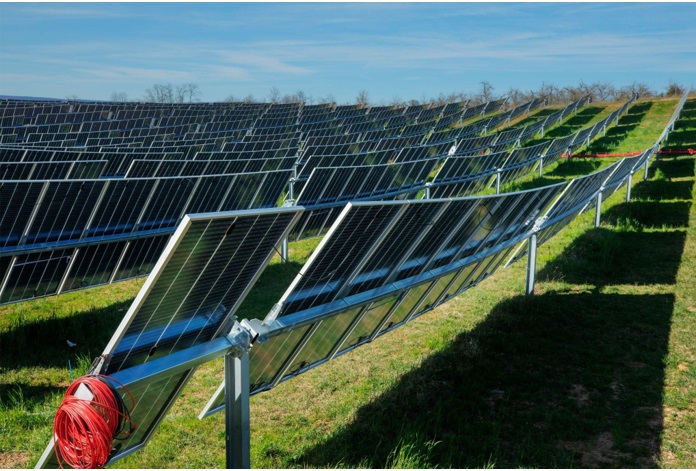When you picture a solar farm, you might imagine a vast, flat desert landscape adorned with neat rows of solar panels.
For years, this image has epitomized the ideal solar site. However, as the demand for renewable energy grows, such “ideal” sites are becoming increasingly scarce. Traditional solar farm site selection criteria focused on flat topography as well as large, contiguous parcels, lack of land features, and mild climate. These criteria often limited the potential sites. Advancements in solar tracker technology are now reshaping the landscape of solar farm site selection and opening up new possibilities for developers.
For example, slopes beyond five degrees were historically considered “unbuildable.” This is because traditional solar trackers typically used continuous torque tubes that don’t flex. Even as torque tubes are being forced to flex, these trackers have limited ability to adapt to undulating terrain, requiring developers to grade the land before installation or use variable foundation reveal heights.
Flattening the land requires bringing in bulldozers and dump trucks, adding to the cost and complexity of the project, as well as creating a negative environmental impact. Some states require significant civil engineering and stormwater management measures to even approve grading, including large and expensive retention ponds, topsoil testing, revegetation measures, and more. Satisfying these requirements can be so expensive that developers may avoid the state entirely.
Solar sites can be disqualified for development for being located in a floodplain, wetland or protected area. The site may also have an increased risk of differential settlement due to earthquakes, soil instability, or a history of underground mining. With trackers more capable of following natural, or shifting, terrain, these issues can be managed.
Solar sites in areas at risk of hurricanes, flooding, and high winds have also historically been ruled out due to the potential damage they can cause to traditional solar trackers and other PV system equipment.
New tracking technologies eliminate the need for costly and time-consuming land grading. Unlike traditional solar trackers that require level ground, an all-terrain tracker can adapt to the land’s natural shape.
Even if a flat site is found, or created, to build a solar power plant, things can change. Over a project lifespan of 30 to 40 years, the ground under a solar project can shift and eventually break or damage long continuous torque tubes.
Think of a sidewalk — when the concrete is freshly poured, everything is perfectly flat and even. But over time, the ground shifts, raising or lowering tiles. Often the rigid sidewalk tiles crack over time from the relative motion.
The same can happen to a solar array if you install a rigid traditional tracker on land affected by differential settlement. By installing flexible bearings instead, the steel piles can shift without disrupting the plant’s performance.
Breaking the paradigm of the long, continuous torque tube required a string of innovations. In addition to the articulating hardware, we needed to reimagine the tracking technology and software controls to ensure that panels can optimally track the sun’s location given the changing slope from bay to bay.

We had to develop tools to enable engineers and contractors to design a construction plan on non-flat terrain, since all of the prior software and modeling tools were only for flat terrain.
An all-terrain solar tracker also offers environmental benefits by reducing the amount of earthwork required. For example, the 170 MW Bartonsville Energy Facility solar project was recently awarded a gold medal by Virginia’s Department of Environmental Quality for going beyond regulatory requirements to improve the environment and promote sustainability. By using a flexible all-terrain tracker to fit to the natural landscape, the project was able to eliminate grading, exceeding the state’s notably strict regulations.
We need to continue to scale up solar development to reach net zero goals. As solar projects are built increasingly in populated areas, community pushback against solar development has become a major risk to our sector’s growth and achievement of climate targets. Solar development need not create negative local environmental consequences for the communities it’s built near.
By allowing solar installations to fit the land in its natural form, we can remove one of the most significant sources of pushback. We shouldn’t have to protect nature from solar development. With responsible development practices, we can actually protect nature with solar development.
One of the most significant benefits of all-terrain solar trackers is their ability to preserve the topsoil on agricultural land. Traditional solar installations often require the removal of topsoil, rendering the land unsuitable for farming in the future.
With all-terrain trackers, the rich topsoil remains intact and native plants can grow around the panels, maintaining and even improving the land’s agricultural value over time. A solar array can be used as a “cover crop” to protect the land for future generations from more permanent forms of redevelopment.
With their ability to adapt to the land’s natural shape, innovative trackers are making solar energy more accessible, cost-effective, and environmentally friendly than ever before. And they’re opening up a world of new possibilities for solar developers.

Yezin Taha is founder and CEO of Nevados, a solar tracker specialist. Prior to Nevados, Taha worked in engineering design and management, project development, energy consulting and bankability for solar projects from GE, Trane, and Black & Veatch. While at Black & Veatch, he discovered major unmet needs in the solar industry for a better mounting solution and he left to form Nevados Engineering to bridge that gap.
The views and opinions expressed in this article are the author’s own, and do not necessarily reflect those held by pv magazine.
This content is protected by copyright and may not be reused. If you want to cooperate with us and would like to reuse some of our content, please contact: editors@pv-magazine.com.








By submitting this form you agree to pv magazine using your data for the purposes of publishing your comment.
Your personal data will only be disclosed or otherwise transmitted to third parties for the purposes of spam filtering or if this is necessary for technical maintenance of the website. Any other transfer to third parties will not take place unless this is justified on the basis of applicable data protection regulations or if pv magazine is legally obliged to do so.
You may revoke this consent at any time with effect for the future, in which case your personal data will be deleted immediately. Otherwise, your data will be deleted if pv magazine has processed your request or the purpose of data storage is fulfilled.
Further information on data privacy can be found in our Data Protection Policy.